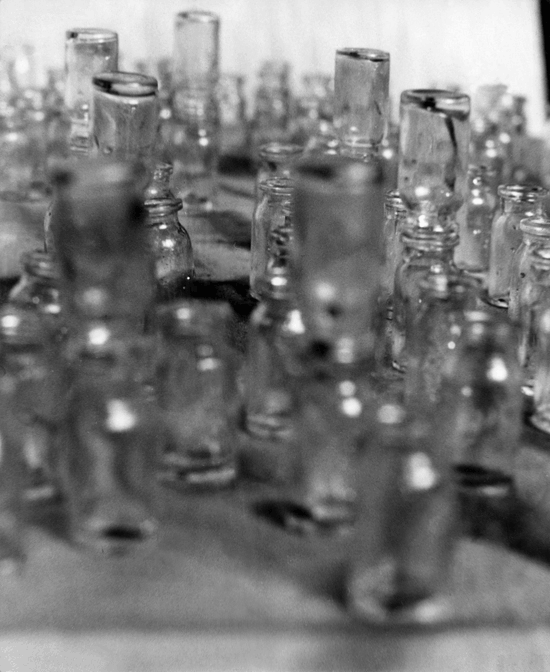Object & Installation

오늘의 시각
1967, 가변설치(페니실린 병, 검은 종이, 끈), ‘청년작가연립전’ (중앙공보관 화랑, 제2실, 서울, 1967) 출품, 국립현대미술관 소장
한국에서 오브제 미술과 설치미술은 1967년 6월 제2회 ‘무’ 동인전부터 시작되었지만, 강국진의 경우에는 미술사적 맥락 속에서 오브제와 설치미술이 갖는 미학적 개념들을 더욱 깊이 탐구하는 것으로 보인다. 한국현대미술사에서 한번도 언급되지 않은 채, 소실되어버린 <오늘의 시각>은 페니실린 병들을 각각 다른 방식으로 줄에 꿰어 매달아 놓은 2개의 설치작품이다. 그것들이 잘 보이도록 2 장의 검은 천이 휘장처럼 벽 위에 붙여져 있다. 그것은 받침대 위에 놓인 3차원 물질을 전제로 하는 전통적인 조각 개념으로부터 벗어나, 줄에 매달려 천정으로부터 반짝거리는 샹들리에처럼 매달려 있는 오브제들이다. 작가는 매달려 있는 페니실린 병들을 과연 ‘조각’이라 간주할 수 있는지에 대해 의문을 제기하는 것처럼 보인다. 원작은 소실되었으며 독립된 작품사진도 남아있지 않아, 전시 현장 사진으로 그 모습을 짐작할 수 있을 뿐이다. (김미경, 미술사학 박사 / 강남대 교수 / 한국예술연구소KARI 대표)
The Vision of today
1967, Variable installation (penicillin bottles, black papers, strings), ‘Chungnyun jakka yeunlipjun’ (Exhibition of young artist’s union), Joong Ang gongbokwan hwarang(Gallery of Joong Ang Public Information Center, 1967), the National Museum of Contemporary Art Korea collection
The first Korean Object art and Installation art was kicked off by the second ‘Mu’ coterie exhibition in February 1967. But it seems to be Kang who really probes into the mechanism of aesthetic concepts. Kang’s Vision of Today, never documented or mentioned in Korean art history, and consequently lost, has several penicillin bottles hung with strings, which consists of two segments. A black sheet cloth on the backwall enables us to see it clearly. Looking like a set of chandelier, it is not a traditionally ordinary 3-D work on an underpinning perch or prop. It seems almost as if he is questioning the identity of his own work as a sculptural 3-D work. This also can only be seen through photographic evidence. (Mikyung Kim / Professor of Art History at Kangnam University / Director of Korean Art Research Institute)
KUKJIN KANG









